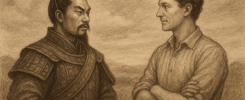Not long ago, I went back to training in Pau with my son Luka. We paddled together, and I was excited about the idea of reconnecting with my old style, of feeling that my body still remembered those sensations. But when I watched myself on video, I could hardly recognize myself. My movements were different: slower in some sections, shorter in others, with stroke styles I had never used before.
At first, it surprised me, even made me uncomfortable. Where was the paddler I remembered? And then I understood: what I was seeing was my 47-year-old body self-organizing, searching for new solutions in an environment that was still the same, but one that I could no longer inhabit in the same way.
That experience reminded me why slalom always forces us to be humble. There is no perfect technique, no universal recipe. The water changes, we change, and the only constant is the need to adapt—and to hold on to a sound technical sense of what Canoe Slalom really is.
Science explains this through the theory of complex dynamic systems: interconnected elements that interact in a non-linear way and generate new properties that cannot be understood by looking at the parts separately. The human body in motion is exactly that. We are not just muscles, bones, and neurons working independently, but a self-structure that integrates the physical, the cognitive, and the emotional in every run.
Two ideas seem key to me here. The first is self-organization: the ability of the system to find order on its own, without anyone directing it. That is exactly what I saw in my videos from Pau—my body reorganizing itself to stay in balance, to run the course with what I have today (or with the little that’s left) and not with what I had more than twenty years ago. The second is emergence: the patterns that arise when all the parts interact. In every descent, something new appears, a way of moving that has never existed before, unique to that moment and to that paddler.
In scientific terms, these stable patterns are called attractors. They are the ways of moving we tend to adopt because they work, because they give us security in the midst of chaos. But they are not rigid. In our sport we don’t just talk about attractors, but about strange attractors: they repeat, yes, but never in exactly the same way. Just when you think you’ve mastered a movement, the river forces you to reinvent it—and that is where the richness lies.
This becomes even clearer when we think about the theory of constraints. A paddler’s movement does not come from copying an ideal model, but from responding to three types of constraints. There are environmental ones: the current, the waves, the wind. There are task constraints: the way the gates are set, how many there are, and so on. And finally, there are individual constraints: the athlete’s body, their energy level, their experience, their confidence in that moment.
What I saw in Pau was the interaction of all these constraints with my own system: I could no longer move as I once did, but I could still find solutions.
At its core, slalom is a dialogue between two complex systems: the river and the paddler. Neither can be fully controlled, but together they generate an emergent movement pattern that is never identical to the last. This is why variability is not a mistake—it is the very essence of the sport. Every run is different, every gesture brings something new. Training in this context means accepting that what matters is not repeating the same thing over and over, but cultivating the ability to adapt.
What’s especially fascinating is watching international competitions, where athletes with completely different body types and facing different water conditions are all able to respond so perfectly to millions of stimuli that, in the end, they are separated by just a few hundredths of a second. That, to me, is amazing.
So, when I watched those videos of myself and could barely recognize my style, I no longer felt it as a loss. I saw it instead as yet another reminder that slalom does not ask us for perfection, but for humility: the ability to accept uncertainty, to trust that our body will find its way, and to learn, once again, how to have a conversation with the river.


